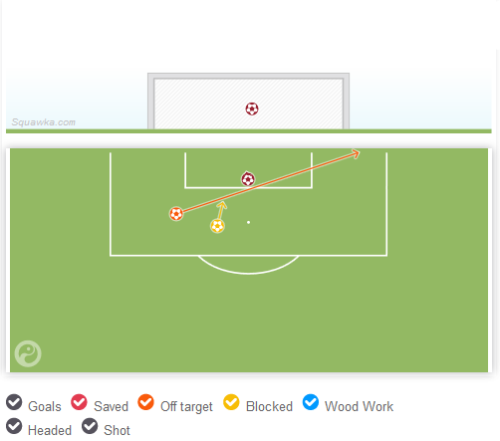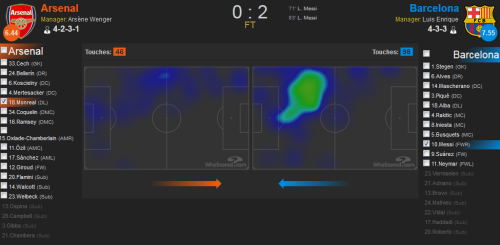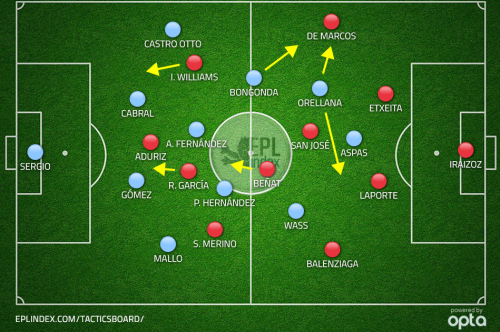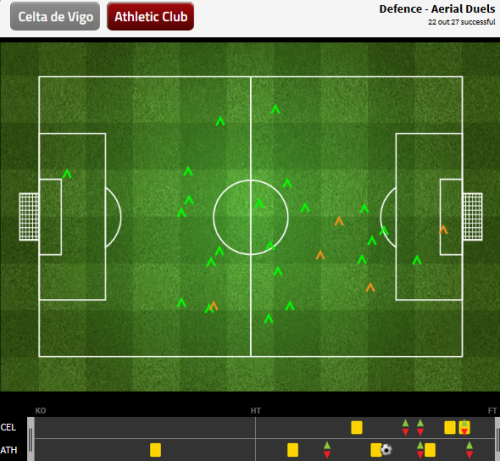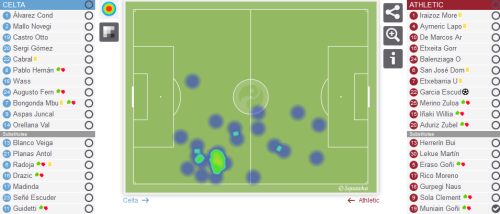Barcelona outclassed Arsenal at the Emirates Stadium to take a huge advantage into the second leg of their UEFA Champions League tie. The Gunners didn’t play poorly and weren’t embarrassed in this match – in fact, they caused the Catalan side plenty of problems – but in the end the better team won quite comfortably and deservedly.
Arsène Wenger didn’t deviate too much from his customary system despite the strength of the opposition, setting up in more or less the habitual 4-2-3-1. Nevertheless, his side did approach the game in a more defensive manner than usual.
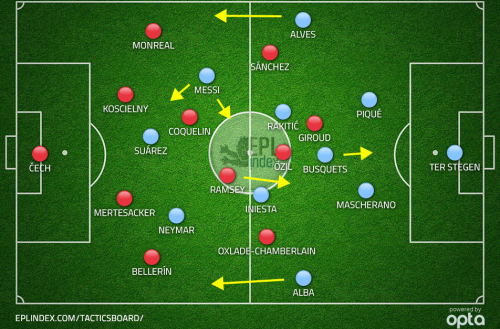
Luis Enrique’s selection was even less surprising, as he stuck with the expected 4-3-3 and fielded his established stars. Marc-André ter Stegen started in goal for this Champions League match, with Claudio Bravo playing in La Liga.
Arsenal started brightly with an aggressive pressing game. Wenger’s men worked hard early on to put pressure on the opposition without the ball. Contrary to what they may be used to, Mesut Özil and Olivier Giroud made perhaps their most important contributions on the defensive end, as the Frenchman dropped back to help the German keep Sergio Busquets on his toes in order to prevent the Spaniard from playing his key role as the pivot, thus disrupting Barça‘s normal passing rhythm. This forced Barcelona to seek other ways of getting the ball from their half to the attacking third.
One option was to try to play out of the back by passing the ball down the flanks. However, the hardworking Alexis Sánchez and Alex Oxlade-Chamberlain hassled Daniel Alves and Jordi Alba, respectively, while Arsenal’s fullbacks played more conservatively than usual to ensure that the Gunners had a spare man by keeping four defenders back to deal with Barcelona’s scintillating front three. Therefore, during the defensive phase of play, the Gunners were essentially organized in a 4-2-4-0, content to cede possession to the Blaugrana‘s center backs as long as the visitors didn’t threaten in more advanced positions.
Another option for Enrique’s side was to try to play long balls forward in an attempt to bypass the first line of pressure. This approach simply didn’t work because of the height advantage that the hosts enjoyed against Barcelona’s attacking players. Per Mertesacker may not be able to match Lionel Messi’s speed on a quick counterattack, but he can feel rather confident in an aerial duel with the Ballon d’Or winner. (See the aerial duels on the diagram above: the English side won nearly every one that took place in its own end of the pitch or in the midfield.)
Finally, the visitors could try to beat Arsenal in the center of the pitch by bringing players back from the front in order to outnumber the opposition in the midfield. Ivan Rakitić and Andrés Iniesta could drop back to help out their fellow midfield, and Messi drifted inside and into deeper positions to provide an additional option. The Argentinian’s movement also dragged Nacho Monreal inside, thus opening up space for Alves to push forward, but Sánchez tracked him diligently to ensure Barcelona didn’t gain an advantage by stretching the Gunners’ defense. This attempt at overloading the middle of the park may have helped Barça retain the ball more easily, but it created problems when the possession did change hands, which happened relatively frequently in the opening stages of the match, when the fresh Arsenal players pressed relentlessly off the ball.
In these moments, the Gunners burst forward explosively. Aaron Ramsey ran up the field from deep, and the home team’s wingers stretched the opposing defense with their pace, while Özil drew the attention of several Barcelona midfield, with Giroud operating as a target man up front. Given the deeper positioning of Enrique’s midfielders, Ramsey’s runs forward were rarely tracked, and the Welshman became a key component of Arsenal’s breaks. (See his shots in the diagram below, which displays the opportunities he had in positions as dangerous as in the penalty area.) The hosts did create chances in this manner but failed to convert them.
However, things clearly weren’t going entirely as planned for Enrique. His team wasn’t playing poorly but nevertheless occasionally appeared shaky defensively and didn’t seem as clinical as usual going forward. The Spaniard responded with a subtle but crucial adjustment, as Busquets dropped back between Javier Mascherano and Gerard Piqué, operating as a third center back, thus allowing Alba and Alves even more freedom. Perhaps even more importantly, the visitors now had a much easier time passing the ball in their usual way. Özil appeared reluctant to follow Busquets so far up the pitch, presumably in the fear of compromising his team’s defensive shape, so there was less pressure on the center backs when they had the ball. Rakitić and Iniesta could drop back when needed to move the football from deeper positions further up the field, with Messi drifting inside to keep up the number of bodies in the midfield, as the liberty Alves now had to play more aggressively allowed the Brazilian to partially fill the resulting void on the right flank, thus continuing to stretch the opposition.
These changes also had indirect benefits on the defensive end, as Barça lost the football in dangerous positions less often, and the Catalan side’s enhanced ball retention tired the hosts, who spent most of the match defending; as a result, Arsenal’s pressing game and counterattacks became less effective. In fact, the Gunners simply struggled during changeovers in general, so not only were they less threatening on the break, but Barcelona’s counterattacks also became more menacing. When Wenger’s side did commit more players to attacking ventures – which they now had to do to create chances due to this new lack of energy in transition – they seemed slower to react when the possession changed hands and were punished by the sharper visitors, who broke the deadlock through an exquisite counter led by their famous front three. The same three forwards combined once more just minutes later in another break, but Luis Suárez was denied by the post. (Furthermore, Messi found himself unmarked at the end of this move, which can be explained by the change in his positioning: Monreal probably didn’t want to follow him into the midfield because that would have left a gaping hole on the left side of his defense and could have weakened his team’s defensive shape. The Spaniard’s heat map is shown on the left in the diagram below; the Argentinian’s is to the right. Messi also earned the penalty kick he converted shortly thereafter to seal the victory.)
Wenger’s substitutions weren’t stupid but ultimately didn’t have much of an impact on the encounter. On the surface, all three of them seemed to be like-for-like swaps, but to be fair the reality may not have been quite so simple. Theo Walcott, Danny Welbeck, and Mathieu Flamini may play similar roles to those fulfilled from the start by Oxlade-Chamberlain, Giroud, and Francis Coquelin, respectively, but they do offer some different characteristics: (1) Walcott poses a more direct threat to the opposing goal; (2) Welbeck is a hard worker and was obviously fresher than the man he replaced, who himself had been working hard for over an hour, which meant that Arsenal’s pressing game and counterattacks could be at least in part reinvigorated by this change; (3) Flamini is perhaps more combative and defensive than Coquelin, which could allow Ramsey to play a more attacking role and reduce the defensive burden on the Welshman, thus affording him the chance to take a bit of a breather to recover. Nevertheless, these adjustments were simply another case of too little, too late, and Arsenal now faces an uphill battle to remain in the Champions League. (It should be noted that the Blaugrana was so untroubled in the final stages of the match that Enrique didn’t feel the need to make a single substitution.)
This was a fascinating first leg in many respects. For one, we got to witness the Gunners put their potent counterattacking game to the test against stronger opposition, though given the quality of the defending champions it may be unfair to use this particular match as a big indicator of its strength. However, we also learned a lot about what it is that makes Barcelona so successful, in particular regarding Sergio Busquets. The midfielder plays a key role in Barça‘s system, operating as a pivot, so many managers have attempted to focus on closing him down in order to suffocate the Catalan side’s passing options. But all good teams have important players and weaknesses; what makes a good team great is the ability to fight back and address its shortcomings in a constructive manner. In this case, Busquets tweaked his game by dropping back between his two center backs in order to help his side take control of the encounter. Indeed, it is better to be proactive, foresee adversity, and take appropriate action before it even becomes necessary, but things do not always go as planned, especially in football, and this adaptability is therefore a crucial trait of the best teams.



